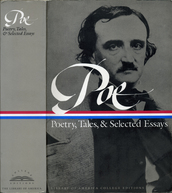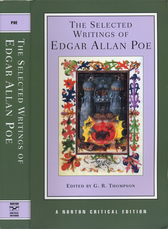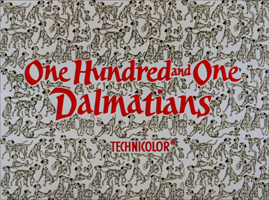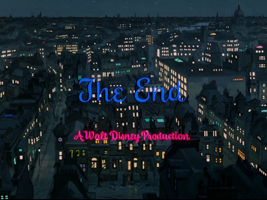Roll 16: 1040 = Edgar Allan Poe
1041 = Poetry and Tales
1043 is The Narrative of Arthur Gordon Pym. Well, I read that too.
This was quite an undertaking.
Prior to this self-assignment, I had read:
of the poetry: The Raven, The Bells, and Annabel Lee
of the tales: MS. Found in a Bottle, Berenice, The Fall of the House of Usher, The Masque of the Red Death, The Pit and the Pendulum, The Tell-Tale Heart, The Gold-Bug, The Black Cat, The Facts in the Case of M. Valdemar, The Sphinx, The Cask of Amontillado, and Hop-Frog
as well as The Narrative of Arthur Gordon Pym.
And possibly a few others, when I was young, that left little impression.
That (minus The Sphinx and maybe also Hop-Frog, and plus Ligeia, William Wilson, The Murders in the Rue Morgue and maybe The Conqueror Worm) seems to me to a fine list of Edgar Allan Poe’s truly “canonical” contributions to literature. Of course there’s room for debate. But the scope of that selection is about right: about 15 famous stories and poems. Beyond its fuzzy borders lies the rest of his output, and the rest of his output is clearly auxiliary. It is very much “other work by Edgar Allan Poe.”
No matter how revisionist and even-handed you want to be, you must accept and embrace that “The Raven” and “Literary Life of Thingum Bob” are two entirely different classes of cultural artifact, just as you must accept that Edgar Allan Poe is a different category of personage from Alfred B. Street, the poet whose work “Winter” occupies the same position in the March 1845 issue of The American Review that “The Raven” did in the February issue.
Ah, but doesn’t The Canon make mistakes? Isn’t the cultural consensus really just a hodgepodge of received wisdom, a big game of “telephone” with nobody at the other end? Doesn’t a lot of this stuff get famous for silly reasons, and then get considered important just for being famous? Aren’t there some treasures in the attic and some lemons in the Louvre? Yes, undoubtedly, there are some. For some people that’s an exciting notion; for others distressing.
When you dig into the other work, the stuff that didn’t pass the Test Of Time, you tend either to hope either that the Test Of Time will turn out to have been rigged (that if it weren’t for the hanging chads, Alfred B. Street would be in the Library of America and Edgar Allan Poe would be languishing deep in google books) or conversely that the forgotten works will be reassuringly bad and the Test Of Time will be vindicated. Which outcome you hope for depends on your personality and your politics.
Sadly, you don’t usually get either kind of satisfaction. I already wrote once about the bitter fact that unspecial, unloved works are generally perfectly good. The larger, even more disheartening truth is that the same goes for the special, loved works. They’re perfectly good. But seen in context and out of the historical limelight, it becomes clear that in pretty much every way, they’re exactly like their siblings. Transcendence is something that happened to them, not something they were born with.
They were born with something, of course, because they lived on where their siblings didn’t. They survived because they were fit, and that fitness is very usually, if not exclusively, related to quality, as we’d like it to be. But Time isn’t a critic; it’s just an evolutionary pressure. Its selections, like evolution’s, are real, significant, and also arbitrary. Are elephants better than mammoths because they’re still around and mammoths are gone? In one sense, yes. But nobody really cares about that sense.
Reading a very well-known story in the context of the author’s complete corpus – loved and unloved alike – can be a little like following a cool friend to his family reunion and suddenly recognizing that his “cool” is just a mannerism shared by every uncle and grandmother in the room, and it isn’t actually cool at all. A third dimension comes into focus, which is humanizing, and to humanize is to diminish.
Or: It can be like seeing the other portraits of Christina Olson and realizing that the famous yearning young woman in “Christina’s World” is actually a 55-year-old cripple crawling pathetically, and that the painting has never tried to disguise that – it’s about that. Despite being famous as something else entirely. (Isn’t it? Isn’t it in waiting rooms because people think it’s a picture of a pretty girl with big dreams, like Belle? I may be wrong.)
Anyway, “The Pit and the Pendulum,” for one, is – all anthological pomp aside – clearly none other than a pulpy piece of dated hackwork, churned out to make a few bucks by feeding a public’s prurient interest in first-person narratives of torture, the more outlandish the better. It’s the 19th-century equivalent of Saw IV, both in aesthetic ambition and cultural significance. “Sensation stories,” they were called, and the phenomenon had been around for years before Poe’s career began. In fact, Poe himself wrote a satirical piece, “How to Write a Blackwood Article,” mocking the formulaic horrors and flimsy pretensions of these junky staples of magazine writing: “Should you ever be drowned or hung, be sure and make a note of your sensations — they will be worth to you ten guineas a sheet.” Etc. This is followed by a parody example, in which his ditzy narrator gets stuck while peering through a hole in a clock face and is very slowly decapitated by the sharpened minute hand, all the while narrating with prissy detachment. It’s an amusing piece (certainly one of the most successful of EAP’s many attempts at comedy, most of which are clumsy and bizarre) but from our standpoint, the snarky disdain rings a bit insincere, seeing as the author is after all Edgar Allan Poe. But how was he to know that in 150 years he’d the only remembered practitioner of this ubiquitous, trashy genre?
That story, “The Scythe of Time” (later dryly retitled “A Predicament”), is a joke – but the swinging blade from “The Pit and the Pendulum,” written four years later, is entirely serious. Or is it? Maybe it’s indulgently campy fun? Or was Poe perhaps sneering cynically from behind his pen, as he served the rabble the slop they deserved? The question of Poe’s personal taste and intent is crucial to a modern reader contending with the fact of his work’s canonization despite its close familial resemblance to the lowest of pulp. The question was crucial to Poe too, because his ego was at stake.
From my point of view, the best defense of Poe’s work is the enlightened dismissal of standard high/low assumptions; the idea that a comic book about aliens can potentially be a great work of art, just as a symphony about the brotherhood of man can potentially be a piece of junk. The best executed of Poe’s stories have a thrilling quality of dim lighting and claustrophobic portent; the savor they offer is full and lasting. There is no more to be asked.
But despite its elegance, that’s a very recent idea, and one that’s still hard for even the most liberal-minded to sustain consistently. It certainly wasn’t available to Poe, at least not to the part of him that worried about things like taste and reputation. And he did worry, at some level. Here he is in his preface to his own anthology, “The Raven and Other Poems”: “In defence of my own taste… it is incumbent upon me to say, that I think nothing in this volume of much value to the public, or very creditable to myself. Events not to be controlled have prevented me from making, at any time, any serious effort in what, under happier circumstances, would have been the field of my choice.” The preferred field being, of course, real poetry – e.g. whatever kind of poetry you the judgmental reader think is respectable.
The following, I believe, is the crux of it. Here is a friend, calling Poe out in a letter: “Some of your bizarreries have been mistaken for satire — and admired too in that character. They deserved it, but you did not, for you did not intend them so.” And here is Poe’s response: “You are nearly, but not altogether right in relation to the satire of some of my Tales. Most of them were intended for half banter, half satire — although I might not have fully acknowledged this to be their aim even to myself.”
“Nearly, but not altogether right,” eh? “Most of them,” eh? Not even to yourself, eh? What you see here, readers, is petty weaseling of the most childish sort, the specialty of the very lonely.
I believe that Poe was a certain pathetic type that we’ve all met: the chronic misfit who, desperate for affection from the human social system that has marginalized him and whose workings he cannot intuit, careens wildly from calculated idiosyncrasy to calculated conformity, hungry for whatever approval he can get but untrainably clueless about how he is perceived. He was, in short, a difficult nerd.
He was the orphaned child of two actors (the Poes), raised by a well-meaning couple (the Allans) who didn’t know what to make of his immoderate nature as it emerged and who left him feeling unloved. He was a trench-coat type by the time he got to high school, and then a willful “character,” drinking and gambling to flamboyant excess, by the time of his stint at UVA. Inspired by the fashion for Byron, he proudly nurtured his most “passionate” tendencies, writing barely coherent, over-the-top poems of visionary yearnings (“Al Aaraaf” is quite an ordeal), burning bridges with the Allans and everyone else, and generally flattering himself that he was a true poet let loose on the world. Then suddenly he finds himself 21 years old, living at his aunt’s house with no prospects and no friends. So he starts entering writing contests, turning out stories that follow various standard middlebrow/sensationalist models but are totally convoluted by his many and conflicting desires to impress – trying to show all at once that he is loftier than the material and disdainful of it, that he is superior to other writers of such stuff and is beating them at their own game, that he is widely read and learned, and that he is an original and independent thinker. Occasionally he forgets himself, however, and manages to write in a state of relative unselfconsciousness. In this state he is naturally driven to indulge his actual and unfashionable sense of fantasy, which, true to his nerddom, is elaborately developed and totally immune to the doctrines of taste.
He writes indefensibly tasteless stories like “Berenice” with obvious relish and commitment, and then deludes himself when confronted, saying that this is the sort of thing the market demands. His career begins to move along and he starts writing snotty reviews in approximately the persona of Comic Book Store Guy, mercilessly trashing books for syntactical errors and irrationalities. He drinks constantly and sloppily, argues loudly with everyone. He has absolutely no idea whether what he’s doing is being a hack or the greatest genius who ever lived, is worried that others know, tries to pre-empt them either way. He marries the only human being he has ever felt close to, his much younger cousin. He suspects that, in the many hours spent alone in his head, he has figured out the deepest secrets of time and space, and starts hinting at them in his writing, hoping someone will notice. He writes “The Raven,” which, when it becomes incredibly popular but as a novelty rather than as a profound work, embarrasses him enough that he feels the need to concoct a “how I wrote The Raven” piece in a professorial mode, making very clear that the poem was no more than a calculated exercise in pleasing the masses.
He loses jobs, shows up drunk for important interviews, sabotages his one distinguished invitation to appear before an audience by reading his unbearable teenage “Al Aaraaf” (Because he actually thinks it’s his only “good” work? Because he doesn’t know and wants to find out? Because he is terrified of people and has no clue?) – and generally doesn’t get anywhere in life despite his steadily expanding reputation. He writes to his wife, as she is dying: “My darling little wife you are my greatest and only stimulus now to battle with this uncongenial, unsatisfactory and ungrateful life.” She dies. He is totally lost. Then he too dies, unexpectedly, while on a trip meant to help him put some of the pieces back together, quite possibly the random victim of thugs.
This is all less than conjectural; it’s just an impression. But reading a man’s life’s work is like reading a man’s life, and whether I’m right or wrong, I certainly feel like over the past year with his book I’ve developed some sense for Poe the man, as though I’ve been in his company and have learned to anticipate his rhythms. This social experience was what made the process difficult. The reading itself was fun; it was the man, the sad, stunted man, that wore me down. The way one feels spending time with a truly maladjusted loser – no matter how warm you try to be, the hopelessness of their social problems eventually becomes oppressive and dispiriting.
In the early poems, Poe opposes vital Fantasy to numbing Science, but at first the conflict is just adolescent self-promotion: his poet’s soul longs for the unearthly, while the fools around him content themselves with drab reality. But somewhere along the way — around the time of the 1831 collection of poetry — he recasts the issue as something less egocentric and more valuable. From the bloggy “Letter to B__” that opens that collection:
[Coleridge] goes wrong by reason of his very profundity, and of his error we have a natural type in the contemplation of a star. He who regards it directly and intensely sees, it is true, the star, but it is the star without a ray — while he who surveys it less inquisitively is conscious of all for which the star is useful to us below — its brilliancy and its beauty. . . . .
Poe intends to get at the nature of experience by intentionally investigating things neither directly nor intensely. He wants to write about the twinkling that will not submit to analysis because it is actually in the eye rather than the star; the things that to the mind seem external but to science seem internal. This standard leads him in a good direction, away from whining and epics, and toward the eerie and psychological. It is essentially the de-romanticization of the romantic aesthetic – still about the seraphs and shades of the mind but no longer so enamored of the individual whose mind it is.
By the time he ends up reusing this very metaphor of the star ten years later in The Murders in the Rue Morgue, there is no longer any implied opposition between the rational and the irrational approach. Poe puts the metaphor in the mouth of his detective hero Dupin, who is simply advocating against the narrow and restrictive approach of the police in favor of a more wide-ranging, imaginative investigation — but one that is still proudly rational. Science, Poe seems to have realized with some pleasure, is simply right. The uncanny does not oppose science but lives within it. In fact, only Dupin’s aggressively rational approach allows him to reach the entirely creepy conclusion that a raging orangutan mutilated the victims. Spoiler, sorry.
This line of thought could be extended, and we could say even broader things about Poe’s body of work — that it is about the rise of science in the popular imagination, about the intersection between industrial materialism and fashionable romanticism, etc. etc. But to say things like this is to get away from the work — these sorts of analyses describe history above and beyond Poe, leaving him as a mere individual bobbing in the greater current. And if we’re only going to use him to get away from him, why read him at all? The real thing is to talk about the work itself, from within its own world.
And, unfortunately for me, that was a depressing world.
While I was going through it, I felt like the best thing I could offer in the end would be to point out a few of the more interesting “lesser” works.
• Morella is sort of a first pass at the more-famous Ligeia, but the overall effect is somewhat less feverish and the gimmick a little creepier, to my mind.
• Eleonora is yet another pass at similar material, this time particularly overcooked in style, but ending on an unexpected note of weird transcendence that I found striking.
• The Conversation of Eiros and Charmion is a destruction of Krypton sort of thing — sci-fi apocalyptic, 100 years before sci-fi apocalyptic became culturally resonant and thus popular. Interesting to see one century’s preoccupations anachronistically explored in the previous century’s style.
• The Colloquy of Monos and Una is, to me, the most eerie and interesting of Poe’s several works set in the heavenly ether-world where dead souls dwell. It’s a long crypto-scientific description of the dissolution of a consciousness after death, reduced gradually from being to non-being over eons. It’s weird, and is a good way to dip a toe into a whole realm of Poe’s output — the mystico-scientific stuff that falls somewhere between crackpot philosophy and crackpot poetry.
• The Philosophy of Furniture is not properly a tale, but it has a poetic bent to it, which I guess was enough for the Library of America people. It’s ostensibly an essay on the effects of tasteful interior architecture and home decoration, but it turns into a long, almost fetishistically loving description of an imagined room.
• The Unparalleled Adventure of One Hans Pfaall finds Poe more or less inventing science fiction, to my mind — focusing on the excitement of the technical and pseudo-scientific details, rather than any overall romance, in his description of flying a hot-air balloon directly upward all the way to the moon. This he bookends, perversely, with some silly-name zaniness and a roly-poly moon-man who seems, in combination with the balloon, like a clear precursor to Oz. It runs overlong and isn’t much of a story, but definitely an intriguing curiosity.
• The Man of the Crowd has a sort of Kafka flavor about it – a little more urban and noir-ish than usual, and more overtly philosophical than others. Though perhaps a bit confused.
Okay, that’s plenty.
So Bloom says Poetry and Tales and then in a separate entry Essays and Reviews, and those are the titles of the two Library of America volumes. They also offer a one-stop Poetry and Tales and Selected Essays paperback, which is what I bought and read. Its footnotes are pretty bare-bones and during “Al Aaraaf” I felt a little at sea, so I sprung for the Norton Edition seen above as a supplement. Unfortunately, it’s the worst sort of reflexive PC academic mushwork, offering strenuously noncommittal commentary on worthless topics like Poe and race, or Poe and politics. All the information relevant to actually reading the works seems mostly undigested — paraphrased with minimal comprehension from other scholars, or from encyclopedias. The selection isn’t bad, but neither is the selection in the Barnes & Noble Poe, I’d imagine. Don’t buy the Norton edition.
Let’s wrap this up with some pictures. The mustachioed, greasy-haired, grim-looking man you see on the cover above, and on bookstore café walls the world over, is Poe in the sad final years of his sad little life. Apparently for most of his life he didn’t look like that. In the interest of encountering the “real” Poe the way I felt I did, here he is being less of an icon, more of a person.
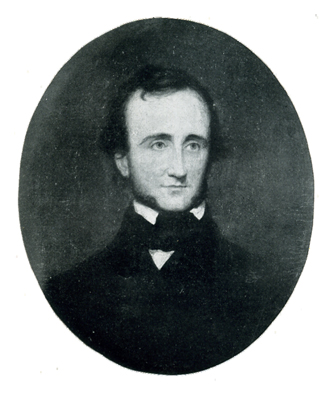
This is the portrait that was said, by those who knew him, to best resemble him.
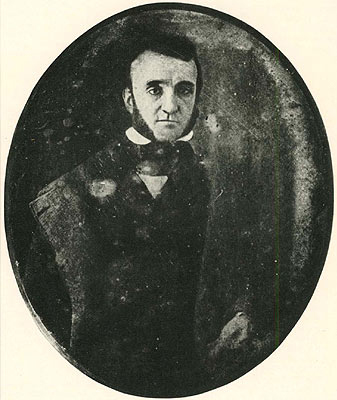
And this is the earliest known photograph of him, from around 1843.
Who is that guy? Just some guy we don’t know. I spent some time getting to know him and I assure you, it was depressing. The superficial relationship I had previously, to an abstract icon of a man’s head and moustache, and to some stories detached from any particular time, place, or personality, was ultimately a more nourishing one for me. And I expect to get it back now that I’m finally done writing this long-ass entry about this long-ass book.
Everyone, I shout to you from the trenches: The Masque of the Red Death is exactly whatever you got out of it when you were eight years old. There’s nothing to see here. Move along.
